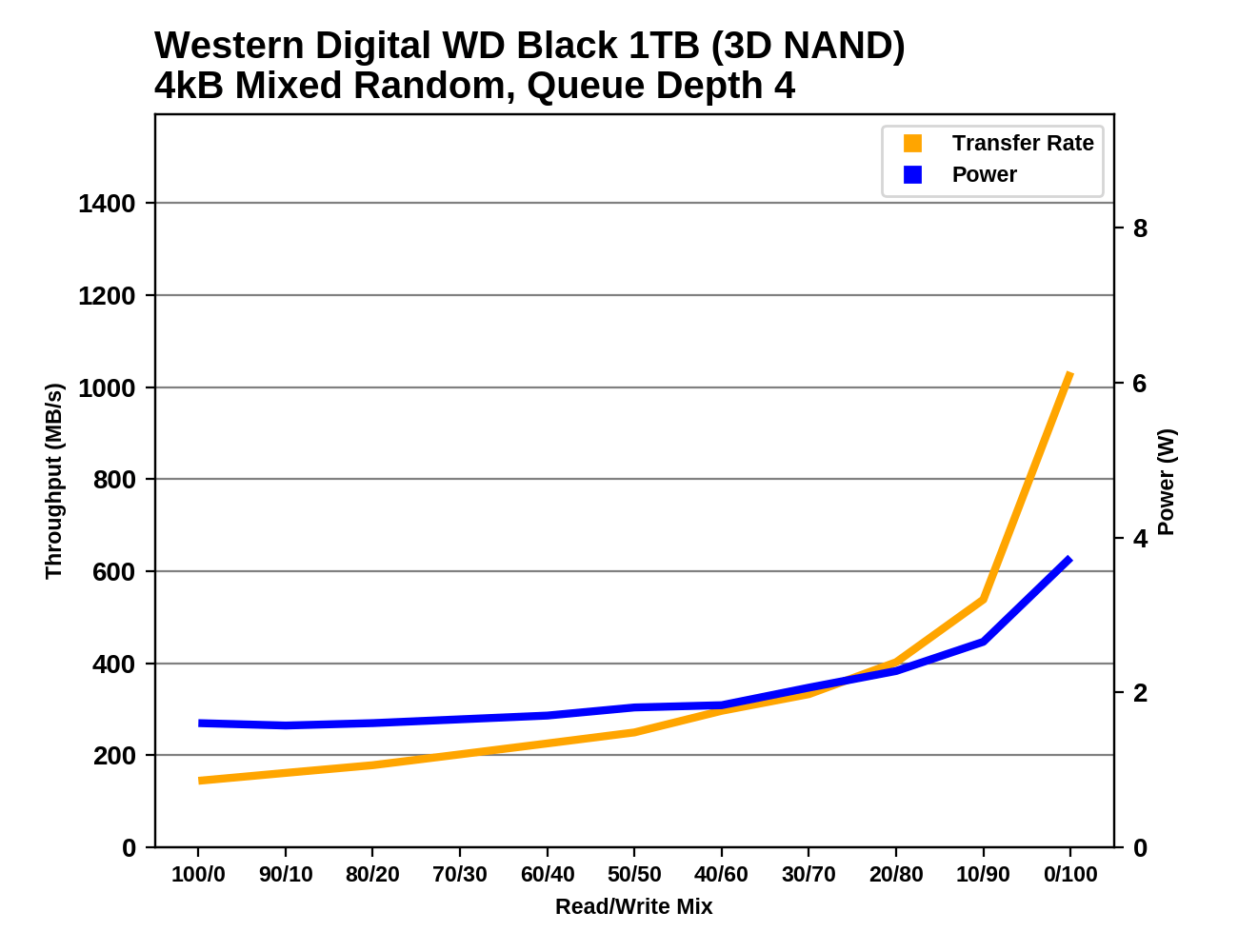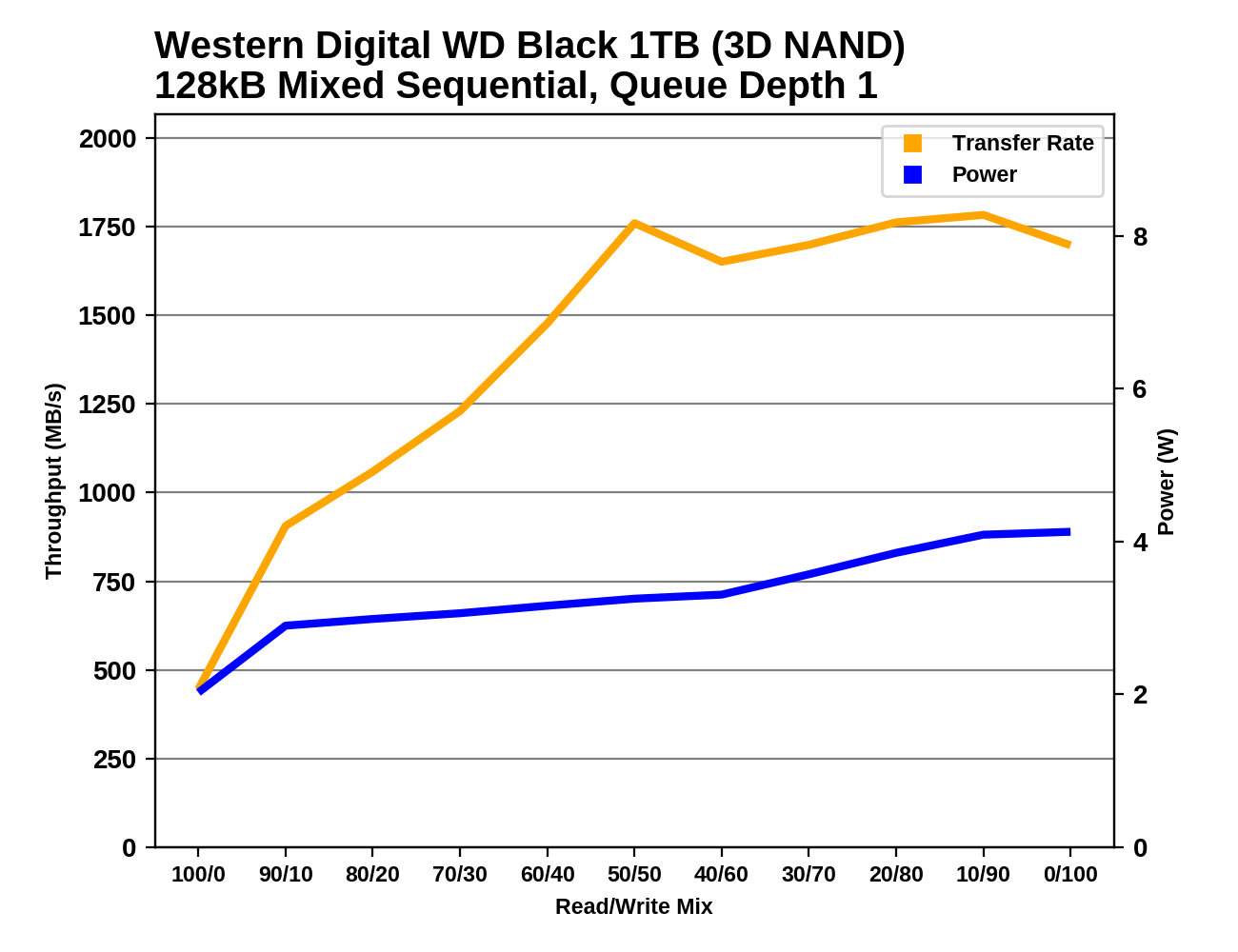The Western Digital WD Black 3D NAND SSD Review: EVO Meets Its Match
by Ganesh T S & Billy Tallis on April 5, 2018 9:45 AM EST- Posted in
- SSDs
- Storage
- Western Digital
- SanDisk
- NVMe
- Extreme Pro
- WD Black
Mixed Random Performance
Our test of mixed random reads and writes covers mixes varying from pure reads to pure writes at 10% increments. Each mix is tested for up to 1 minute or 32GB of data transferred. The test is conducted with a queue depth of 4, and is limited to a 64GB span of the drive. In between each mix, the drive is given idle time of up to one minute so that the overall duty cycle is 50%.

The WD Black offers great mixed random I/O performance, but it is still slightly slower overall than the best drives from Samsung, and the Optane SSD is in an entirely different league.
 |
|||||||||
| Power Efficiency in MB/s/W | Average Power in W | ||||||||
The WD Black's power efficiency on the mixed random I/O test is about the same as that of the Samsung 960 PRO, and close to the Optane SSD in spite of the vast difference in absolute performance level.
 |
|||||||||
The performance of the WD Black grows very slowly as the workload shifts from reads toward writes, but near the end of the test the good SLC write caching implementation gives the WD Black steep gains. Power consumption is under 2W for most of the test and doesn't quite reach 4W at the very end.
Mixed Sequential Performance
Our test of mixed sequential reads and writes differs from the mixed random I/O test by performing 128kB sequential accesses rather than 4kB accesses at random locations, and the sequential test is conducted at queue depth 1. The range of mixes tested is the same, and the timing and limits on data transfers are also the same as above.

The mixed sequential workload performance of the WD Black is surprisingly good, just barely behind the Optane SSD and far ahead of almost all flash-based SSDs.
 |
|||||||||
| Power Efficiency in MB/s/W | Average Power in W | ||||||||
The WD Black draws about the same power as other SSDs during the mixed sequential test, and combined with the great performance that translates to a huge lead in power efficiency.
 |
|||||||||
The performance scaling pattern of the WD Black on the mixed sequential test is quite unusual. Many drives show a bathtub curve with peak performance at either end of the test when the workload is pure reads or pure writes, and the worst performance in the middle of the test. By contrast, the WD Black starts out rather slowly but rapidly speeds up during the first half of the test, and stays near full performance for the entire second half.










69 Comments
View All Comments
Chaitanya - Thursday, April 5, 2018 - link
Nice to see some good competition to Samsung products in SSD space. Would like to see durability testing on these drives.HStewart - Thursday, April 5, 2018 - link
Yes it nice to have competition in this area and important thing to notice here a long time disk drive manufacture is changes it technology to meet changes in storage technology.Samus - Thursday, April 5, 2018 - link
Looks like WD's purchase of SanDisk is showing some payoff. If only Toshiba would have taken advantage of OCZ (who purchased Indilinx) in-house talent. The Barefoot controller showed a lot of promise and could have easily been updated to support low power states and TLC NAND. But they shelved it. I don't really know why Toshiba bought OCZ.haukionkannel - Friday, April 6, 2018 - link
Indeed! Samsung did have too long time performance supremesy and that did make the company to upp the prices (natural development thought).Hopefully this better situation help uss customers in reasonable time frame. Too much bad news to consumers last years considering the prices.
XabanakFanatik - Thursday, April 5, 2018 - link
Whatever happened to performance consistency testing?Billy Tallis - Thursday, April 5, 2018 - link
The steady state QD32 random write test doesn't say anything meaningful about how modern SSDs will behave on real client workloads. It used to be a half-decent test before everything was TLC with SLC caching and the potential for thermal throttling on M.2 NVMe drives. Now, it's impossible to run a sustained workload for an hour and claim that it tells you something about how your drive will handle a bursty real world workload. The only purpose that benchmark can serve today is to tell you how suitable a consumer drive is for (ab)use as an enterprise drive.iter - Thursday, April 5, 2018 - link
Most of the tests don't say anything meaningful about "how modern SSDs will behave on real client workloads". You can spend 400% more money on storage that will only get you 4% of performance improvement in real world tasks.So why not omit synthetic tests altogether while you are at it?
Billy Tallis - Thursday, April 5, 2018 - link
You're alluding to the difference between storage performance and whole system/application performance. A storage benchmark doesn't necessarily give you a direct measurement of whole system or application performance, but done properly it will tell you about how the choice of an SSD will affect the portion of your workload that is storage-dependent. Much like Amdahl's law, speeding up storage doesn't affect the non-storage bottlenecks in your workload.That's not the problem with the steady-state random write test. The problem with the steady state random write test is that real world usage doesn't put the drive in steady state, and the steady state behavior is completely different from the behavior when writing in bursts to the SLC cache. So that benchmark isn't even applicable to the 5% or 1% of your desktop usage that is spent waiting on storage.
On the other hand, I have tried to ensure that the synthetic benchmarks I include actually are representative of real-world client storage workloads, by focusing primarily on low queue depths and limiting the benchmark duration to realistic quantities of data transferred and giving the drive idle time instead of running everything back to back. Synthetic benchmarks don't have to be the misleading marketing tests designed to produce the biggest numbers possible.
MrSpadge - Thursday, April 5, 2018 - link
Good answer, Billy. It won't please everyone here, but that's impossible anyway.iter - Thursday, April 5, 2018 - link
People do want to see how much time it takes before cache gives out. Don't presume to know what all people do with their systems.As I mentioned 99% of the tests are already useless when it comes to indicating overall system performance. 99% of the people don't need anything above mainstream SATA SSD. So your point on excluding that one test is rather moot.
All in all, it seems you are intentionally hiding the weakness of certain products. Not cool. Run the tests, post the numbers, that's what you get paid for, I don't think it is unreasonable to expect that you do your job. Two people pointed out the absence of that tests, which is two more than those who explicitly stated they don't care about it, much less have anything against it. Statistically speaking, the test is of interest, and I highly doubt it will kill you to include it.